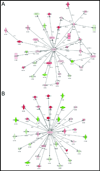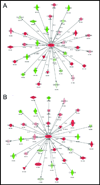A Murine Model of K-RAS and β-Catenin Induced Renal Tumors Expresses High Levels of E2F1 and Resembles Human Wilms Tumor
- PMID: 25934441
- PMCID: PMC4782590
- DOI: 10.1016/j.juro.2015.04.090
A Murine Model of K-RAS and β-Catenin Induced Renal Tumors Expresses High Levels of E2F1 and Resembles Human Wilms Tumor
Abstract
Purpose: Wilms tumor is the most common renal neoplasm of childhood. We previously found that restricted activation of the WNT/β-catenin pathway in renal epithelium late in kidney development is sufficient to induce small primitive neoplasms with features of epithelial Wilms tumor. Metastatic disease progression required simultaneous addition of an activating mutation of the oncogene K-RAS. We sought to define the molecular pathways activated in this process and their relationship to human renal malignancies.
Materials and methods: Affymetrix® expression microarray data from murine kidneys with activation of K-ras and/or Ctnnb1 (β-catenin) restricted to renal epithelium were analyzed and compared to publicly available expression data on normal and neoplastic human renal tissue. Target genes were verified by immunoblot and immunohistochemistry.
Results: Mouse kidney tumors with activation of K-ras and Ctnnb1, and human renal malignancies had similar mRNA expression signatures and were associated with activation of networks centered on β-catenin and TP53. Up-regulation of WNT/β-catenin targets (MYC, Survivin, FOXA2, Axin2 and Cyclin D1) was confirmed by immunoblot. K-RAS/β-catenin murine kidney tumors were more similar to human Wilms tumor than to other renal malignancies and demonstrated activation of a TP53 dependent network of genes, including the transcription factor E2F1. Up-regulation of E2F1 was confirmed in murine and human Wilms tumor samples.
Conclusions: Simultaneous activation of K-RAS and β-catenin in embryonic renal epithelium leads to neoplasms similar to human Wilms tumor and associated with activation of TP53 and up-regulation of E2F1. Further studies are warranted to evaluate the role of TP53 and E2F1 in human Wilms tumor.
Keywords: Wilms tumor; animal; beta catenin; kidney; models; oncogenes.
Copyright © 2015 American Urological Association Education and Research, Inc. Published by Elsevier Inc. All rights reserved.
Figures






Similar articles
-
Functional KRAS mutations and a potential role for PI3K/AKT activation in Wilms tumors.Mol Oncol. 2017 Apr;11(4):405-421. doi: 10.1002/1878-0261.12044. Epub 2017 Mar 15. Mol Oncol. 2017. PMID: 28188683 Free PMC article.
-
β-Catenin and K-RAS synergize to form primitive renal epithelial tumors with features of epithelial Wilms' tumors.Am J Pathol. 2011 Dec;179(6):3045-55. doi: 10.1016/j.ajpath.2011.08.006. Epub 2011 Oct 8. Am J Pathol. 2011. PMID: 21983638 Free PMC article.
-
CTNNB1 mutations and overexpression of Wnt/beta-catenin target genes in WT1-mutant Wilms' tumors.Am J Pathol. 2004 Dec;165(6):1943-53. doi: 10.1016/s0002-9440(10)63246-4. Am J Pathol. 2004. PMID: 15579438 Free PMC article.
-
Is Wilms tumor a candidate neoplasia for treatment with WNT/β-catenin pathway modulators?--A report from the renal tumors biology-driven drug development workshop.Mol Cancer Ther. 2013 Dec;12(12):2619-27. doi: 10.1158/1535-7163.MCT-13-0335. Epub 2013 Nov 20. Mol Cancer Ther. 2013. PMID: 24258344 Free PMC article. Review.
-
Wilms' tumours: about tumour suppressor genes, an oncogene and a chameleon gene.Nat Rev Cancer. 2011 Feb;11(2):111-21. doi: 10.1038/nrc3002. Epub 2011 Jan 20. Nat Rev Cancer. 2011. PMID: 21248786 Free PMC article. Review.
Cited by
-
Functional KRAS mutations and a potential role for PI3K/AKT activation in Wilms tumors.Mol Oncol. 2017 Apr;11(4):405-421. doi: 10.1002/1878-0261.12044. Epub 2017 Mar 15. Mol Oncol. 2017. PMID: 28188683 Free PMC article.
-
Identification of a gene-expression predictor for diagnosis and personalized stratification of lupus patients.PLoS One. 2018 Jul 5;13(7):e0198325. doi: 10.1371/journal.pone.0198325. eCollection 2018. PLoS One. 2018. PMID: 29975701 Free PMC article.
-
Pharmacologic Inhibition of β-Catenin With Pyrvinium Inhibits Murine and Human Models of Wilms Tumor.Oncol Res. 2017 Nov 2;25(9):1653-1664. doi: 10.3727/096504017X14992942781895. Epub 2017 Jul 10. Oncol Res. 2017. PMID: 28695795 Free PMC article.
-
Claudin-2 inhibits renal clear cell carcinoma progression by inhibiting YAP-activation.J Exp Clin Cancer Res. 2021 Feb 23;40(1):77. doi: 10.1186/s13046-021-01870-5. J Exp Clin Cancer Res. 2021. PMID: 33622361 Free PMC article.
-
Genetic and chromosomal alterations in Kenyan Wilms Tumor.Genes Chromosomes Cancer. 2015 Nov;54(11):702-15. doi: 10.1002/gcc.22281. Epub 2015 Aug 14. Genes Chromosomes Cancer. 2015. PMID: 26274016 Free PMC article.
References
-
- Grovas A, Fremgen A, Rauck A, et al. The National Cancer Data Base report on patterns of childhood cancers in the United States. Cancer. 1997;80:2321. - PubMed
-
- Sonn G, Shortliffe LM. Management of Wilms tumor: current standard of care. Nat Clin Pract Urol. 2008;5:551. - PubMed
-
- Green DM, Grigoriev YA, Nan B, et al. Congestive heart failure after treatment for Wilms' tumor: a report from the National Wilms' Tumor Study group. J Clin Oncol. 2001;19:1926. - PubMed
-
- Dome JS, Cotton CA, Perlman EJ, et al. Treatment of anaplastic histology Wilms' tumor: results from the fifth National Wilms' Tumor Study. J Clin Oncol. 2006;24:2352. - PubMed
Publication types
MeSH terms
Substances
Grants and funding
LinkOut - more resources
Full Text Sources
Other Literature Sources
Medical
Molecular Biology Databases
Research Materials
Miscellaneous

